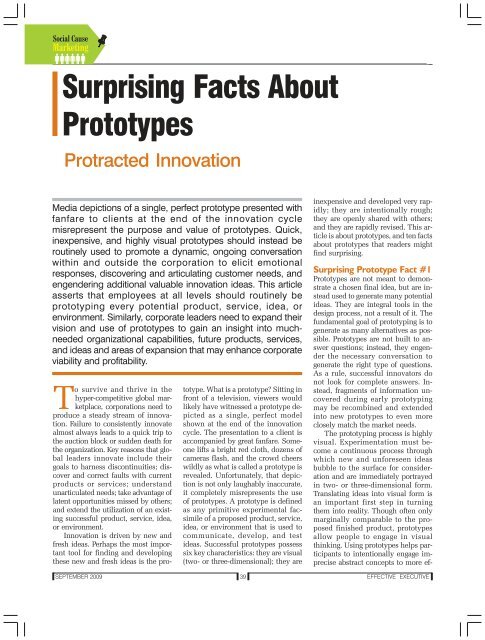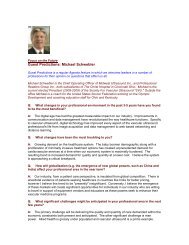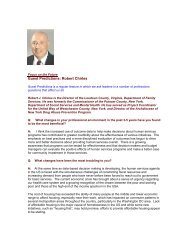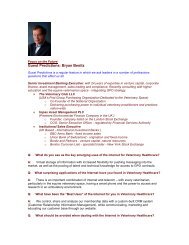Social Cause Marketing - The Regis Group Inc
Social Cause Marketing - The Regis Group Inc
Social Cause Marketing - The Regis Group Inc
Create successful ePaper yourself
Turn your PDF publications into a flip-book with our unique Google optimized e-Paper software.
Surprising Facts About<br />
Prototypes<br />
Protracted Innovation<br />
Media depictions of a single, perfect prototype presented with<br />
fanfare to clients at the end of the innovation cycle<br />
misrepresent the purpose and value of prototypes. Quick,<br />
inexpensive, and highly visual prototypes should instead be<br />
routinely used to promote a dynamic, ongoing conversation<br />
within and outside the corporation to elicit emotional<br />
responses, discovering and articulating customer needs, and<br />
engendering additional valuable innovation ideas. This article<br />
asserts that employees at all levels should routinely be<br />
prototyping every potential product, service, idea, or<br />
environment. Similarly, corporate leaders need to expand their<br />
vision and use of prototypes to gain an insight into muchneeded<br />
organizational capabilities, future products, services,<br />
and ideas and areas of expansion that may enhance corporate<br />
viability and profitability.<br />
To survive and thrive in the<br />
hyper-competitive global marketplace,<br />
corporations need to<br />
produce a steady stream of innovation.<br />
Failure to consistently innovate<br />
almost always leads to a quick trip to<br />
the auction block or sudden death for<br />
the organization. Key reasons that global<br />
leaders innovate include their<br />
goals to harness discontinuities; discover<br />
and correct faults with current<br />
products or services; understand<br />
unarticulated needs; take advantage of<br />
latent opportunities missed by others;<br />
and extend the utilization of an existing<br />
successful product, service, idea,<br />
or environment.<br />
Innovation is driven by new and<br />
fresh ideas. Perhaps the most important<br />
tool for finding and developing<br />
these new and fresh ideas is the prototype.<br />
What is a prototype? Sitting in<br />
front of a television, viewers would<br />
likely have witnessed a prototype depicted<br />
as a single, perfect model<br />
shown at the end of the innovation<br />
cycle. <strong>The</strong> presentation to a client is<br />
accompanied by great fanfare. Someone<br />
lifts a bright red cloth, dozens of<br />
cameras flash, and the crowd cheers<br />
wildly as what is called a prototype is<br />
revealed. Unfortunately, that depiction<br />
is not only laughably inaccurate,<br />
it completely misrepresents the use<br />
of prototypes. A prototype is defined<br />
as any primitive experimental facsimile<br />
of a proposed product, service,<br />
idea, or environment that is used to<br />
communicate, develop, and test<br />
ideas. Successful prototypes possess<br />
six key characteristics: they are visual<br />
(two- or three-dimensional); they are<br />
inexpensive and developed very rapidly;<br />
they are intentionally rough;<br />
they are openly shared with others;<br />
and they are rapidly revised. This article<br />
is about prototypes, and ten facts<br />
about prototypes that readers might<br />
find surprising.<br />
Surprising Prototype Fact #1<br />
Prototypes are not meant to demonstrate<br />
a chosen final idea, but are instead<br />
used to generate many potential<br />
ideas. <strong>The</strong>y are integral tools in the<br />
design process, not a result of it. <strong>The</strong><br />
fundamental goal of prototyping is to<br />
generate as many alternatives as possible.<br />
Prototypes are not built to answer<br />
questions; instead, they engender<br />
the necessary conversation to<br />
generate the right type of questions.<br />
As a rule, successful innovators do<br />
not look for complete answers. Instead,<br />
fragments of information uncovered<br />
during early prototyping<br />
may be recombined and extended<br />
into new prototypes to even more<br />
closely match the market needs.<br />
<strong>The</strong> prototyping process is highly<br />
visual. Experimentation must become<br />
a continuous process through<br />
which new and unforeseen ideas<br />
bubble to the surface for consideration<br />
and are immediately portrayed<br />
in two- or three-dimensional form.<br />
Translating ideas into visual form is<br />
an important first step in turning<br />
them into reality. Though often only<br />
marginally comparable to the proposed<br />
finished product, prototypes<br />
allow people to engage in visual<br />
thinking. Using prototypes helps participants<br />
to intentionally engage imprecise<br />
abstract concepts to more ef-<br />
SEPTEMBER 2009<br />
39<br />
EFFECTIVE EXECUTIVE








